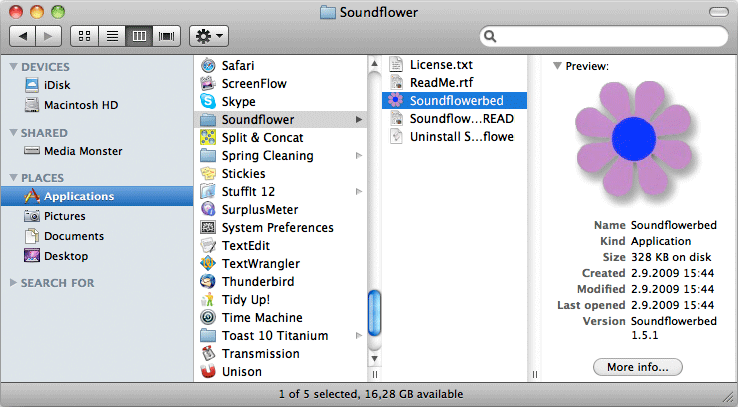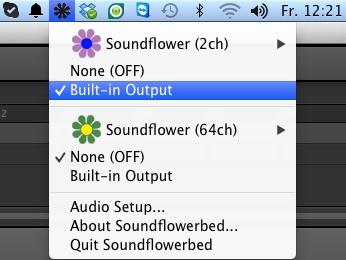Soundflower is an open source kernel extension for MacOS, designed to create a virtual audio output device that can also act as an input. Initial development and maintenance of Soundflower was done by Cycling '74. In 2014, Cycling '74 passed stewardship of Soundflower to Rogue Amoeba, but we ultimately didn't have the time or resources to. Jul 21, 2017 Soundflower is a OS X system extension that allows applications to pass audio to other applications. Soundflower is easy to use, it simply presents itself as an audio device, allowing any audio application to send and receive audio with no other support needed. Soundflower is free, open-source, and runs on Mac Intel and PPC computers. It's possible to capture sounds your Mac makes as well as audio streamed from the Internet. And you can do it for free with Soundflower. Soundflower is a free audio system extension that allows applications to pass audio to other applications. Soundflower emulates the interface of an audio device but allows any audio application to send and receive audio with no other support needed. It opens as one of two audio devices (2ch/16ch).
How To Use Soundflower
Free Inter-application Audio Routing Utility for macOS
Soundflower presents itself as one of two audio devices (2ch / 16ch). The 2-channel device is sufficient for most situations.
To send the output of one application to another, select Soundflower as the output device in the first application and Soundflower as the input device within the second application.
If an application does not allow you to specify audio devices, you can make Soundflower the default input or output device inside the Sound panel in the System Preferences, or with the Audio MIDI Setup utility application.
The 16-channel device is provided for more complex routing situations, and can be used with more than two applications simultaneously if the applications support audio routing to any channel, as Max/MSP does.
Note that Soundflower’s audio channels represent a global audio space. If more than one application is sending its output to the same channel, the audio will be mixed. If you want an application to send and receive audio through Soundflower, (for instance using Max/MSP to manipulate and return another application’s audio) you must send and receive the audio on different audio channels or a feedback loop will be created.
If you are hearing clicks or breakups, try increasing the buffer size of both applications (set within each application).
Applications
Since Soundflower offers a straight forward method of communicating between applications on the Mac, there are a variety of situations where you can employ it.
Podcasting
Soundflower has been used extensively in podcasting by combining separate streams of audio into one source. Instead of recording an interview with Skype and only hearing one voice, Soundflower lets you publish both voices for a complete interview experience.
Soundflower For Mac 10.14
Cellphone
Use an application called DittyBot and Skype to access your iTunes collection from any cellphone.
Music
Record streaming audio from iTunes into Audacity, or route an audio stream from iTunes to Logic.
Soundflowerbed
When using Soundflower to send audio to and from applications, you may find that you are not able to send audio through another device to monitor audio output. In such situations you can use Soundflowerbed, an application that resides in the Finder’s Menubar allowing you to tap into Soundflower channels and route them to an audio device.
Download: Soundflower 1.6.6 Installer (includes SoundflowerBed) -- Use this for OS 10.6 - OS 10.8
https://code.google.com/archive/p/soundflower/downloads
System Requirements
Soundflower 1.5.1 requires Mac OS 10.5.
Soundflower 1.4.3 requires Mac OS 10.4.
Soundflower 1.3.1 requires Mac OS 10.2.8 or later.
Mac Topics That May Interest You:
VST & Audio Units Plug-ins in Mac OS XSM Pro Audio VFX Software for Intel Mac OS X
How to setup Garage Band, Sound-flower, IAC, VFXApple's Boot Camp
SoundFlower ConfigurationGarageBand Aggregate Device
IAC (Inter-Application Communication) BusAudacity VST Enabler
WACVST (Windows-Mac VST)VSTAU Manager (VST to AU Adapter)
How To Use SoundflowerHow to capture audio with Soundflower

VSTis a trademark of Steinberg Soft- und Hardware GmbH
A signed Soundflower. Note that the Soundflower extension is signed, but the installer is not! You will have to hold the control key down to open the Soundflower.pkg installer for the first time.
PLEASE READ! NEW SECURITY STEPS REQUIRED BY APPLE
The first time you run the installer (Soundflower.pkg), it will ask for your admin password, and will FAIL! A security alert will appear, with a button to take you to System Preferences 'Security & Privacy - General' pane. Once there, there should be an 'Allow' button (**) that you will need to click on to give permission to use Soundflower (developer: MATT INGALLS). Then, RUN THE INSTALLER AGAIN. It should inform you installation was successfull.
(**) If you see an 'Open Anyway' button in the Security Preferences, this is something different!!! Most likely because you tried (and failed) opening the installer by double clicking without holding down the control key. If so, click the 'Open Anyway' button which will display another window. Then click the 'Open' button in that window to launch the installer. Now you can follow the instructions above to get the 'Allow' button to appear in the Security Preferences.
Soundflower For Mac Safe

Soundflower For Windows
NOTE: This is only the Soundflower kernel extension. The SoundflowerBed app is retired. A new replacement is in the works. In the meantime, you can take your chances with an older version of Soundflowerbed, but you can do a lot with a Multi-Output Aggregate Device. Here's an example:
Say i want to play some audio in iTunes, but record it in Quicktime while listening to it out of the built-in speakers. Here is how i would set it up:
*in iTunes:
start playing audio
Open Audio MIDI Setup: (found in /Applications/Utilities)
hit the '+' button in the bottom left corner and select 'Create Multi Output Device'
in the the panel that appears on the right, select 'Built-in Output' AND 'Soundflower (2ch)'
then hit the button with the gear icon bottom left and select 'use this device for sound output' (you should still be hearing your iTunes output -- it is now going to both Soundflower and the built-in speakers)
Then In Quicktime:
create a new audio recording
in the popup menu next to record button select 'Soundflower (2ch)' as the input
(you should now see record levels changing)
hit record!